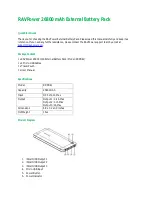
GB
11
ces, such as gasoline or solvents cannot be
ignited when you are using the car and motor-
cycle battery charger!
EXPLOSIVE GASES!
Avoid flames and sparks!
Ensure sufficient ventilation when charging.
Put the battery onto a well-ventilated surface
when charging. Otherwise, the device can
be damaged.
EXPLOSION HAZARD!
Ensure that the positive pole connection ca-
ble has no contact with a fuel line (e.g. petrol
line)!
DANGER OF CAUSTIC BURNS!
Protect your eyes and skin from caustic burns
from the acid (sulphuric acid) when it comes
into contact with the battery!
Use: acid-resistant safety goggles, clothing
and gloves! If your eyes or skin have come
into contract with the sulphuric acid, flush the
affected body region with plenty of clear, run-
ning water and seek medical advice at once!
Avoid electrical short circuits when connecting
the car and motorcycle battery charger to the
battery. Connect the minus pole connection
cable only to the minus pole of the battery or
the car body. Connect the plus pole connec-
tion cable only to the plus pole of the battery!
Before connecting to the mains, verify the
mains power has the required 230 V~ 50 Hz,
a 16 A fuse and an ELCB switch (earth leaka-
ge circuit breaker)! Otherwise, the device can
be damaged.
Do not use the car and motorcycle battery
charger near any fires, heat and long-term
temperatures above 50 °C! For higher
temperatures, the output power of the car
and motorcycle battery charger will drop au-
tomatically.
Only use the car and motorcycle battery char-
ger with the original parts it was
delivered with!
Do not cover the car and motorcycle battery
Summary of Contents for ULGD 5.0 C1
Page 4: ......












































